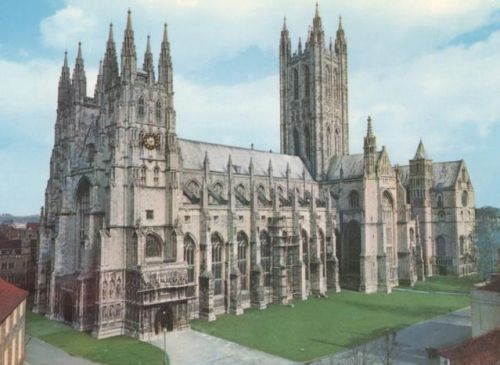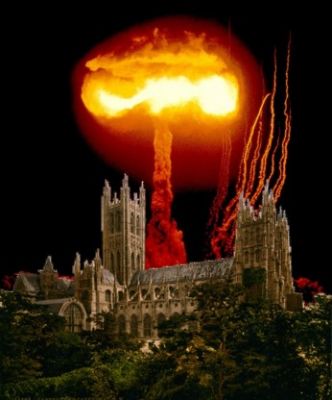AP twists Anglican timeline (again)
 Another Lambeth Conference has come and gone and, as you may have noticed, there wasn't much happening in the way of news. That is, of course, the real news. The archbishop of Canterbury and his staff managed to hold a global meeting of most of the Anglican bishops without anything really bad happening in front of the mainstream press. The headline for this event: Stay the course.
Another Lambeth Conference has come and gone and, as you may have noticed, there wasn't much happening in the way of news. That is, of course, the real news. The archbishop of Canterbury and his staff managed to hold a global meeting of most of the Anglican bishops without anything really bad happening in front of the mainstream press. The headline for this event: Stay the course.
But there is a problem. Various parts of the Anglican Communion continue to chart separate courses, which was true before Lambeth and that's still true now.
The bishops who came to Canterbury -- as opposed to the 200-plus that did not -- agreed that they hope to hang together, somehow. They agreed to produce a new covenant that will draw a few crucial doctrinal borders. Maybe. Someday.
And repeat after me, again: "The Africans pray, the Americans pay and the British write the resolutions." Who do you think will write this covenant? And, with Lambeth about $2 million in the red by many estimates, do you think the small, but very rich, and thus powerful, American church will have any chips to play in this game of high-church poker? By the way, there were 135 American bishops at this conference, out of the 650 present.
The New York Times offers a few basic facts to sum things up:
The push for a covenant amounted to a stratagem for finding both short- and long-term solutions to a dispute that has bitterly divided an estimated 80 million Anglicans worldwide. The split has expressed itself most keenly in the starkly opposed views of traditionalists, primarily in Africa and Asia, who oppose any concessions on homosexuality, and of more liberal elements, especially in the United States and Canada, who favor the ordination of openly gay and lesbian clergy members and church blessings of same-sex unions.
Archbishop Williams told reporters that he hoped Anglican leaders could agree on a draft covenant within a year, but said that winning approval for it among the 44 national and regional churches of the Anglican Communion could take until 2013. That period might coincide with a push among the bishops here to hold another Lambeth meeting after only five years.
In the meantime, the archbishop said, agreement was widespread for continuing "moratoria" on the ordination of gay and lesbian priests and blessings of same-sex unions and for matching restraint by conservatives who threatened to walk out unless traditional views proscribing church acceptance of homosexuality prevailed.
"Continuing"? There has been a moratorium on strategic actions on the left and the right? How did I miss that?
Meanwhile, the most important words in the short Washington Post story about the Lambeth finale were right there in the byline above the lede:
By Karla Adam Special to The Washington Post Monday, August 4, 2008; A-8
LONDON, Aug. 3 -- In the end, the 2008 Lambeth Conference will probably be remembered most for the bishop who was not in attendance but who nonetheless threatened to break apart the world's third-largest church.
Note, in addition to the fact that this story ran on A-8, those telltale words "Special to ..." That means that the Post did not send a reporter to cover this event.
Without a doubt, high travel costs and falling revenues had a major impact on Lambeth coverage this time around. This means that the basic Associated Press story by veteran Rachel Zoll is even more important than ever, since it will run in many newspapers from coast to coast and in other parts of the world.
 I am sad to report that it repeats one of the most important myths in recent coverage of the local, national and global Anglican wars. Here we go again:
I am sad to report that it repeats one of the most important myths in recent coverage of the local, national and global Anglican wars. Here we go again:
The 77 million-member Anglican Communion has been splintering since 2003, when the U.S. Episcopal Church consecrated the first openly gay bishop, V. Gene Robinson of New Hampshire.
Williams barred Robinson and a few other bishops from the meeting, and designed the event without legislation or votes, instead focusing on rebuilding frayed relationships.
So what is wrong with that? Well, click here and head on over to the home page of the Anglican Mission in the Americas, one of several conservative networks that is working with Global South bishops to offer alternative parishes and leadership for Episcopalians and others. There you will find this piece of history:
In a groundbreaking response to the western crisis, some leaders of the Anglican Church in Africa and Asia acted to provide seeds of hope for the dire situation in the U.S., by establishing the Anglican Mission in America (AMiA) .
In 2000, Archbishops Emmanuel Kolini (Province of Rwanda) and Moses Tay (Province of South East Asia) consecrated the Rev. Chuck Murphy and the Rev. Dr. John Rodgers as missionary bishops to the U.S. At a gathering in Amsterdam on July 28 of the same year, the Anglican Mission in America was formalized as a missionary outreach charged with fulfilling the Great Commission through church planting. Four additional bishops were consecrated in Denver in 2001 by Archbishop Kolini and Archbishop Yong Ping Chung (Archbishop Tay's successor who served as archbishop until his retirement in February 2006).
Note the dates on those extra-legal consecration services -- 2000 and 2001.
Those shots over the Episcopal bow took place well before 2003, right? In fact, if you look at a more detailed timeline of the Anglican wars, you'll see that things have been rolling right along for a quarter of a century or longer.
So it is simply wrong to say that Anglicanism "has been splintering since 2003." Also, there are a variety of doctrinal issues involved in the fighting, not just the raising of one noncelibate gay male to the episcopate.
A correction is needed. Alas.